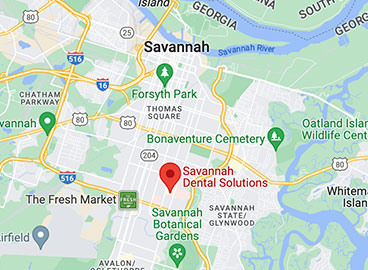If you’re typical, you probably brush your teeth at least twice a day (once in the morning and once before you go to bed.) You probably know you should be flossing your teeth regularly, too … but if you’re honest you’ll probably admit you don’t do it nearly as often as you should. In fact, statistics indicate that almost 80 percent of people fail to floss.
Flossing takes time. It can also be uncomfortable or even painful (which actually means you should be doing it more often.) If you understand exactly why dentists recommend flossing your teeth once a day and how to floss the right way, you’ll be more likely to fit this important step into your daily routine.
Why Dentists Recommend You Floss Your Teeth Daily
Flossing is the term dentists use to refer to the act of cleaning between the surfaces of the teeth using dental floss. Dentists recommend that people floss their teeth regularly (in addition to brushing their teeth regularly) because flossing has repeatedly been shown to improve oral health and prevent cavities and gum disease. Brushing your teeth removes plaque and decay-causing material from the tooth surfaces the toothbrush bristles can reach.
Flossing removes plaque and decay-causing materials from the crevasses between the teeth that toothbrush bristles can’t reach. If these materials are not removed, they degrade and turn into microbes that cause cavities, gum disease, and bad breath.
Compelling Research Proves the Benefits of Flossing
For a study published in a 2008 issue of the Journal Periodontal, researchers at New York University studied 51 pairs of twins between the ages of 12 and 21 to assess the effects of flossing on oral health. Half of the twins participated in a regimen of tongue brushing and tooth brushing. The other half of the twins participated in a regimen of tongue brushing, tooth brushing, and flossing. Researchers collected samples from participants to assess how prevalent 26 plaque-causing microbe species were in the mouths of each participant before the study began and after the study ended.
The results were conclusive: the group that did not floss as part of its oral-hygiene regimen had “overabundant” amounts of cavity- and periodontal-disease causing microbes in their mouths. Researchers concluded that twins who flossed for 2 weeks reduced the amount of microbes associated with oral disease.
How to Floss Properly
Dentists agree and research backs up the fact that flossing is an important step in keeping your teeth and gums healthy. Why do so many people forego this step? One reason is that they’re flossing incorrectly, thus causing themselves pain and discomfort that leads them to eventually skip this important step altogether.
Choose the right type of dental floss. If your gums are sensitive, choose a waxed or single-filament floss that will slide easily between the teeth without shredding.
Choose the right amount of dental floss. Ideally, cut an 18-inch or so length of floss for each flossing session.
Employ proper flossing technique. Wind most of the dental floss around the middle fingers of each hand (divided equally between the left and the right hand). You should have about an inch or two left to work between your teeth.
Firmly grip the inch or two of floss between your thumbs and index fingers. Gently and slowly work it between teeth in a vertical motion. Curve the dental floss around the bottom of each tooth, gently slipping it beneath the gumline to lift out debris. As you move from one tooth to the next, release more floss from your middle fingers so each tooth segment uses a clean section of floss.
After you have gently and thoroughly flossed between all teeth, discard the dental floss. Gently rinse your mouth with lukewarm water, swish, and spit. This will remove any residual food particles and microbes from your mouth.
If you can’t floss, use a floss alternative. Life is unpredictable and busy, and there will definitely be times when it’s not convenient or possible to perform a “textbook floss.” In these situations, you can improvise.
-
- • Flossing picks or sticks are not as effective as dental floss but are acceptable in a pinch.
-
- • Sugar-free gum chewed for 20 minutes after a meal will help dislodge decay and encourage saliva production.
-
- • Last but not least, swish water forcibly between your teeth to clear away food particles, then spit out the water.
We’re all born with one set of permanent teeth. When they’re gone, they’re gone! Flossing regularly is one of the most effective ways to ensure the health of your teeth and gums, and ensure your natural pearly whites will last and serve you well as long as possible.
Married dentists Chad and Alexandra Schnabel welcome you to Savannah Dental Solutions. From caring children’s dentistry to high-tech cosmetic procedures and even full-mouth reconstruction, we blend the latest technology with traditional customer-oriented values. To start your journey to better oral health, call us today at (912) 354-1366.







